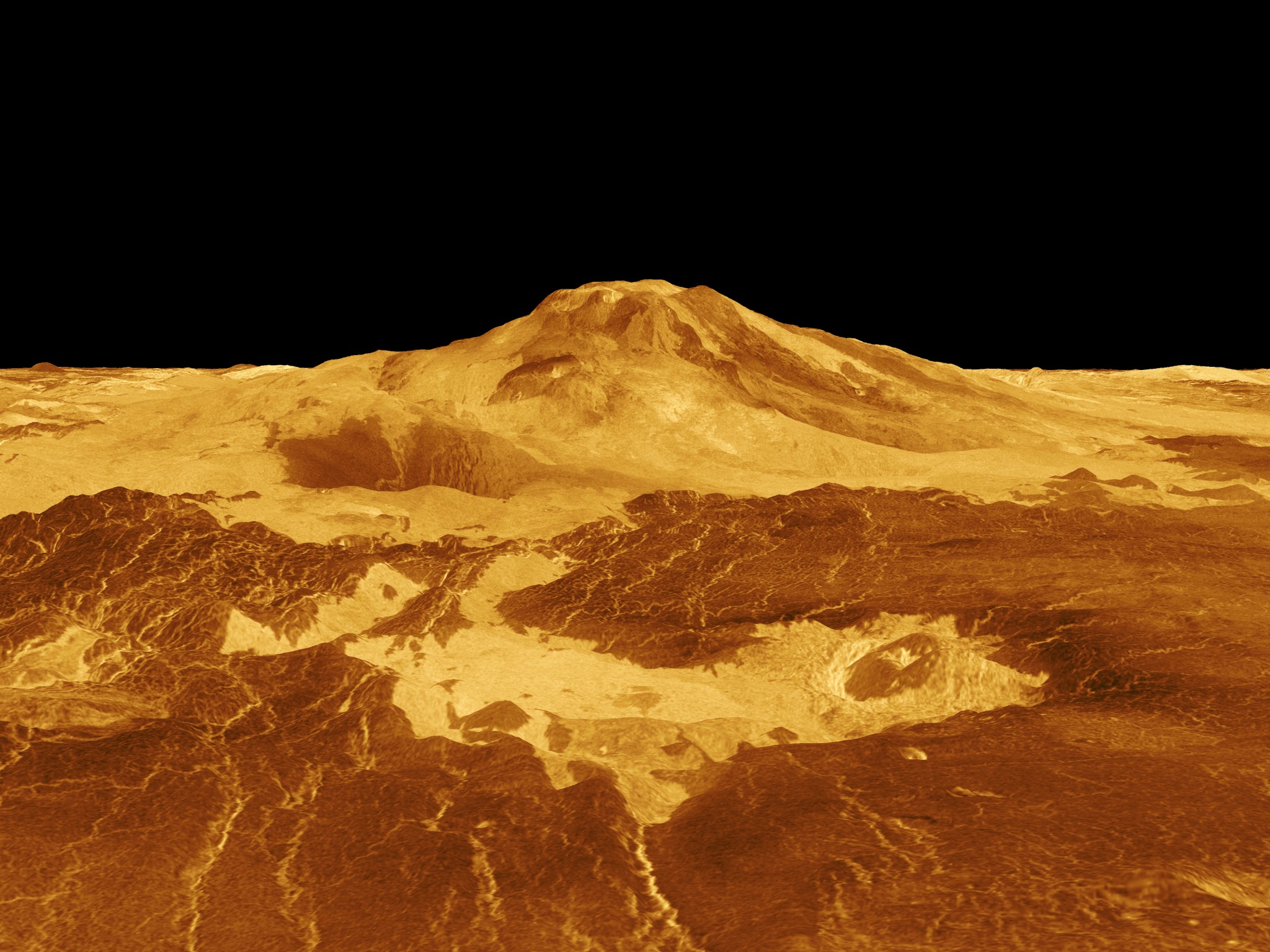A proposed mission called DAVINCI+ could one day fly the first U.S. spacecraft since 1978 to study the atmosphere of Venus. On Feb. 13, NASA announced that DAVINCI+, named after the visionary Renaissance artist and scientist Leonardo da Vinci, is one of four teams selected under the agency’s Discovery Program to develop concept studies for new missions in this decade to various intriguing destinations in the solar system. Out of these four finalists, NASA will select one or two missions for flight by summer 2021.
DAVINCI+ is a mission concept designed by scientists and engineers at NASA’s Goddard Space Flight Center in Greenbelt, Maryland. Among its primary objectives is to explore the past and present Venus atmosphere, which is made mainly of carbon dioxide, with clouds of sulfuric acid and other unknown chemicals. Venus’ thick atmosphere, 90 times denser than Earth’s, traps heat that bakes the surface to a scorching 900 degrees Fahrenheit (480 degrees Celsius), which is hot enough to melt lead.
But despite these drastic features, Venus is actually somewhat similar to Earth: It’s about the same size and may have been formed from similar materials. And once upon a time, scientists suspect Venus could have even looked and behaved much like our planet, including having oceans covering its rocky surface.
To understand why the evolution of Venus strayed so far from Earth’s, the DAVINCI+ team proposes dropping a spherical probe through the planet’s atmosphere, all the way to the surface, to sniff out the molecules making up each layer. Among other elements, the team intends to seek out noble gases such as krypton, argon, neon and xenon. Because these rare gases are inert, they can shed light on the long history of chemical and geological processes that formed and shaped Venus and its atmosphere. DAVINCI+ would also seek atmospheric chemical remnants that resulted from the loss of water in the distant past to reveal whether Venus ever had persistent surface oceans.
“Our vision for DAVINCI+ is to send a chemistry lab and orbiter to Venus to put the planet into its appropriate context in our solar system,” said Jim Garvin, NASA Goddard’s chief scientist and principal investigator of the proposed DAVINCI+ mission. “Then we can compare Venus, Earth, and Mars — terrestrial sister planets that probably looked similar at birth, but somehow diverged paths quite drastically.”
Leading the DAVINCI+ mission concept with Garvin, who’s been studying Venus for 40 years, will be deputy principal investigators Stephanie Getty, deputy director of Goddard’s Solar System Exploration Division and a specialist in science instrument development, and Giada Arney, a Goddard planetary scientist who specializes in Venus and Venus-like planets around other stars.
Credits: NASA’s Goddard Space Flight Center
Download this video in HD formats from NASA Goddard’s Scientific Visualization Studio
Besides illuminating the evolution of planets in our solar system, the lessons learned through DAVINCI+, Arney notes, could inform observations of rocky, potentially habitable planets in other planetary systems. “Because there may be Venus-like planets around other stars,” said Arney, “it’s important to better understand the world next door so that we may be able to improve our interpretation of future observations of these far-off, analog worlds.”
Now that the DAVINCI+ mission concept has been selected to move forward in the design process, the Goddard team will spend around nine months developing a final proposal, called a Concept Study Report. This includes refining the mission design to mitigate potential technical risks, ensuring science goals stay preserved in the face of competing financial priorities, and determining the timeline for getting the spacecraft and probe ready for the team’s proposed launch in 2026.
Based on the current mission concept, the DAVINCI+ spacecraft, upon arrival to Venus, would drop a spherical probe full of sensitive instruments through the planet’s atmosphere. These instruments include the same types of mass spectrometer, built at Goddard, and tunable laser spectrometer, built at NASA’s Jet Propulsion Laboratory in Pasadena, California, that are currently inside the Sample Analysis at Mars analytical chemistry lab aboard NASA’s Curiosity rover on Mars. On the Red Planet, these instruments are sniffing the atmosphere and ingesting soil in order to learn more about the evolution of habitable conditions there.
With their proposed probe, the DAVINCI+ team hopes to one day get the chance to acquire the first high-precision atmospheric chemistry measurements taken from the top of Venus’ clouds to the near surface, where carbon dioxide gas, bizarrely, behaves more like a liquid due to the high pressure environment. A descent imaging system designed by Malin Space Science Systems would seek to provide the first high-resolution images and 3D topographic data for Venus’ Alpha Regio mountainous region, which has intriguing geologic features that could reveal details about the planet’s tectonic and sedimentary history. The images and topographic data could show scientists at a super high resolution how Venus’ massive atmosphere interacts with the surface.
Months after releasing the probe, the team hopes the DAVINCI+ spacecraft would enter orbit to map the planet for a full Venus year, which is 225 Earth days long. Among other information, the orbiter would capture ultraviolet images of Venus’ day side that would allow scientists to study the uppermost atmosphere and cloud deck. On the night side, the spacecraft would capture infrared images of major highlands such as Ishtar Terra, a region that reveals a different part of Venus’ geologic story and details of the evolution of its uppermost layer, or crust.
“Goddard and partners are very excited to have this opportunity to try to bring the U.S. back to Venus, a frontier often forgotten since it is technically challenging,” Getty said.

To learn more about NASA’s Discovery Program and the four missions selected to finalize their designs, click here.
Story by Lonnie Shekhtman
NASA’s Goddard Space Flight Center, Greenbelt, Md.

























